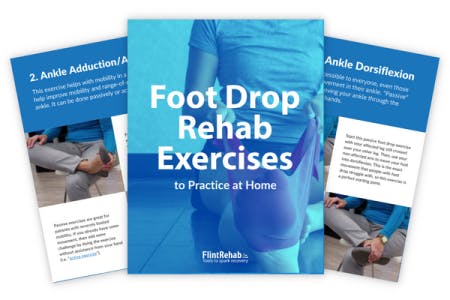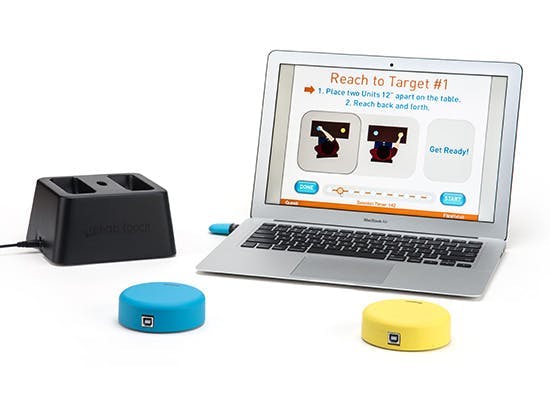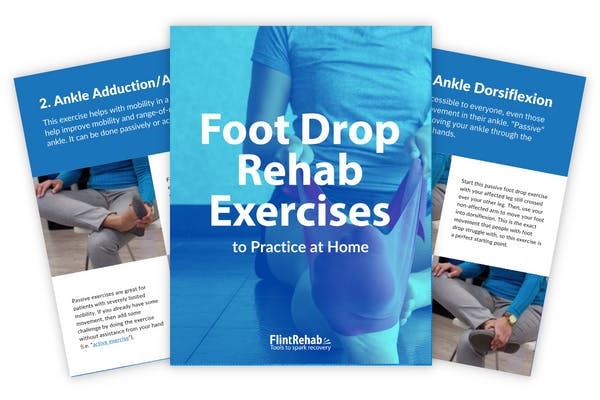No products in the cart.
No products in the cart.
No products in the cart.
No products in the cart.
Home » Neurological Recovery Blog » Neurological Recovery » Can Foot Drop Be Cured Without Surgery?
Last updated on September 27, 2023

Individuals experiencing foot drop often wonder, “can foot drop be cured without surgery?” The short answer is yes, it is possible to cure foot drop without undergoing surgery. There are many treatments for foot drop, with surgery being reserved only for the most persistent cases. Before resorting to surgery, doctors typically recommend using other rehabilitative techniques to recover.
So how can foot drop be cured without surgery? Therapeutic exercises, along with the use of an ankle-foot orthotic and/or electrical stimulation, may allow individuals to recover from foot drop after a neurological injury.
In this article, the appropriate circumstances for using surgery to cure foot drop will be discussed. Conservative treatment options, as well as the rationale for pursuing these treatments, will also be outlined.
Please use the links below to jump directly to any section of this article.

Image from Wikipedia
Foot drop is a condition which impairs the ability to perform dorsiflexion – the act of flexing the foot back toward the shin. It often occurs after a nerve injury or neurological condition, both of which can impair communication between the brain and the muscles involved in ankle dorsiflexion.
While surgery may eventually be recommended to address foot drop, doctors and therapists typically advise individuals to exhaust all conservative foot drop treatments first. This is because surgery is invasive and costly, while non-surgical interventions may be just as effective.
Conservative treatments for foot drop often center around restoring communication between the brain and the muscles responsible for ankle dorsiflexion. When foot drop occurs due to a stroke, traumatic brain injury, or spinal cord injury, therapists may focus on activating neuroplasticity to restore this communication pathway.
Neuroplasticity is the process through which the brain and spinal cord can be adaptively rewired. This can allow a healthy area of the brain or spinal cord to assume control of functions affected by neurological damage. Since neuroplasticity is activated by repetitive practice, consistently performing therapeutic exercises and tasks can promote neuroplasticity and boost recovery.
While the best way to address foot drop is by treating the underlying neurological injury, it is also possible to manage foot drop through compensatory techniques such as using an ankle-foot orthotic. These techniques allow individuals to keep their foot from dropping temporarily, but do not promote long-term recovery.
When conservative treatments have failed to improve foot drop, doctors and therapists may recommend undergoing surgery. Although surgery should be considered only as a last resort, the majority (up to 94%) of patients are satisfied with their surgical results.
There are a few different surgical interventions available to address foot drop. If the cause of foot drop is due to a known nerve injury that can be addressed, nerve decompression, repair, or reconstruction surgery may be recommended.
These surgeries can repair the broken connections within the neuromotor pathway responsible for ankle dorsiflexion, allowing the brain to accurately deliver messages to the ankle muscles. However, for those without a known peripheral nerve injury who have experienced foot drop for over a year, a tendon transfer may be performed.
Tendon transfer surgery involves surgically moving a working tendon in the leg, often the tibialis posterior tendon, and attaching it to a different area of the leg to make dorsiflexion possible. Unlike nerve decompression, repair, or reconstruction surgeries, which address the root cause of foot drop, tendon transfer surgeries focus simply on restoring ankle movement.
For those who have had a stroke, traumatic brain injury, or other neurological injury, doctors and therapists may suggest considering surgery if foot drop has not improved after one year of treatment. Foot drop surgery is an invasive and permanent procedure, which is why conservative options are recommended first.
With hard work and consistency, many individuals can regain movement in their ankle without resorting to surgery. Before considering surgery for foot drop, it is frequently recommended to pursue rehabilitation on a regular basis for at least one year.
Conservative foot drop treatments that may be recommended to try before considering surgery include:
The best way to treat foot drop naturally is to restore the neurological pathway involved in activating the muscles that control dorsiflexion. Practicing foot drop exercises can activate neuroplasticity and retrain the brain and spinal cord to accurately transmit information to the ankle muscles.
Foot drop exercises involve movements such as active toe taps and assisted toe raises to retrain the brain how to lift the front of the foot. The more often foot drop exercises are practiced, the more likely that dorsiflexion will improve.
This is because each time an individual repeats foot drop exercises, the new neural pathways that control dorsiflexion are strengthened. Foot drop exercises are the most natural, non-invasive, and effective way to heal foot drop.
Want 13 pages of foot drop exercises in a beautiful PDF? Click here to download our free Stroke Rehab Exercise ebook now (link opens a pop up for uninterrupted reading)
Although foot drop exercises can be very effective, recovery takes time. To maximize results, many try combining foot drop exercises with electrical stimulation (e-stim).
E-stim involves providing gentle electrical stimulation through electrode pads placed on the skin. The electrical signals can activate targeted muscles and stimulate the affected neuromuscular pathway, promoting movement through neuroplasticity.
E-stim is most effective when used in conjunction with foot drop exercises rather than as a stand-alone treatment. However, caution should be used when using e-stim on areas of the body with impaired sensation, as burns may occur. Always talk with a therapist before beginning e-stim treatments to learn how to use an e-stim unit safely and effectively.
Because foot drop increases the risk of falling, it is recommended to use an ankle-foot orthotic (AFO) to improve safety. An AFO, such as the Flex AFO from Flint Rehab, is an orthotic device used to control foot and ankle movements. This can stabilize the ankle and prevent the toes from dragging.
While AFOs may greatly improve an individual’s safety and gait (manner of walking), orthotics are considered to be a compensation tool. This is because the nerves and muscles involved in ankle dorsiflexion are not actively working when using an AFO, therefore using one does not facilitate healing.
Since AFOs are a form of compensation, they do not encourage active movement of the weakened foot and ankle muscles. This can lead to learned nonuse, which refers to when muscles are used so little that they gradually deteriorate until they are no longer able to used.
However, there is an appropriate time and place for AFO use. Especially when recommended by a therapist, an AFO can and should be used while performing activities of daily living to improve one’s safety.
To combat learned nonuse, dedicate time every day to intentionally using the ankle and foot and practicing foot drop exercises. This will prevent learned nonuse while rewiring the brain to improve dorsiflexion. Over time, weaning away from AFO use can allow individuals to regain ankle movement and promote recovery.
While rehabilitative exercises, e-stim, and AFOs are among the most common non-surgical foot drop treatments, there are other interventions that may also be effective. Consider consulting a physical therapist to learn more about conservative foot drop treatments in order to recover without surgery.
Foot drop is a condition in which individuals are unable to lift the front portion of the foot, often caused by a miscommunication between the brain and the ankle muscles involved in dorsiflexion. One of the best treatments for foot drop is practicing rehabilitative exercises targeting the ankle muscles. Consistently and repetitively performing therapeutic foot drop exercises can help rewire the brain and improve dorsiflexion.
Other therapeutic interventions are frequently used in conjunction with exercises in order to optimize results. For example, e-stim can be used to stimulate the nerves and muscles for improved mobility, while AFOs can improve safety and stability of the ankle for walking. Surgical interventions, such as nerve decompressions and repairs or tendon transfers, are only used to treat foot drop after all other interventions have failed.
In summary, the answer to the question, “can foot drop be cured without surgery?” is a resounding yes. It is possible to cure foot drop without surgery using rehabilitative exercises and interventions. Talk with a doctor or therapist regarding which foot drop treatments may be most effective for you.

Get our free ebook filled with 14 pages of foot drop exercises featuring photos of licensed therapists. Sign up below to get your copy! We never sell your email address, and we never spam. That we promise.


Do you have this beautiful (and free!) foot drop exercise PDF?
Get a free copy of our ebook Foot Drop Exercises to Try at Home Click here to get instant access.
“When my 84-year-old Mom had a stoke on May 2, the right side of her body was rendered useless. In the past six months, she has been blessed with a supportive medical team, therapy team, and family team that has worked together to gain remarkable results.
While she still struggles with her right side, she can walk (with assistance) and is beginning to get her right arm and hand more functional. We invested in the FitMi + MusicGlove + Tablet bundle for her at the beginning of August.
She lights up when we bring it out and enjoys using it for about 20 to 30 minutes at a time. While she still doesn’t have enough strength to perform some of the exercises, she rocks the ones she can do! Thanks for creating such powerful tools to help those of us caring for stroke patients. What you do really matters!”
-David H.
FitMi is a neurorehab device that you can use from the comfort of home. It works by motivating you to accomplish high repetition of therapeutic exercises.
As you work through the program, you’ll unlock more difficult exercises when you’re ready. It’s like having a virtual therapist available anytime you need it.
See how quickly Sudhir was able to notice improvements:
“I bought FitMi about a month and a half ago. Quite impressed with the range of exercises for hand, arm, leg and foot. I suffered a stroke about 2 years ago which paralyzed my right side. I do walk now with a cane or walker, but my right hand curls up and my right arm is also weak. Within a few days of trying it out, I could note a distinct improvement in stamina before tiring. So, I am looking forward to continued improvement.”
-Sudhir
Not only is FitMi approved by survivors, but it’s also approved by therapists, too. FitMi is used in some of the top clinics in the world, including the Shirley Ryan Ability Lab, the #1 ranked rehab hospital in America. Plus, two PTs on YouTube with over 3 million subscribers (you may know them as Bob & Brad) gave FitMi the thumbs up, too.
To learn more about this motion-sensing, game-changing recovery tool, click the button below:
Grab a free rehab exercise ebook!
Sign up to receive a free PDF ebook with recovery exercises for stroke, traumatic brain injury, or spinal cord injury below: